
Aker Restaurant & Lounge

He said:
Aker Restaurant and Lounge is a high-end Japanese-Latin fusion restaurant that specializes in creative cocktails, robata grilling (grilling over an open flame), and dry-aged sushi. Everything from the décor to the tableware to the food was meticulously and beautifully presented, a treat for the eyes as well as the palate. Really, the only part of my experience that wasn’t absolutely delightful was their choice of music. Kathy called it techno-bop or something like that. I simply told her it was “young people music.” Fortunately, it wasn’t too loud, but I did find it a bit distracting.
Fusion was evident in the décor as well as the cuisine. The dining room was quite modern. Though simple, the design was romantic and sophisticated, with clean lines, intimate lighting, and welcoming touches of blossoms, flowers, and plants.

We began with a couple of starter plates: a salad called “Sunomono Kimchee” and a Yakatori skewer of Kurabuta pork belly. Although I like a good kimchee, we don’t usually order it because Kathy doesn’t care for the spiciness. Our waiter told us that this one was tangy and sweet and not very spicy. I wasn’t sure if Kathy’s sensitive palate could trust him, but I decided I would give it a try.
The salad consisted of Persian cucumbers, marinated in a sweet namasu vinegar and kimchee glaze. The cucumbers were indeed sweet. The vinegar added a pleasant tang, but I told Kathy I didn’t sense any spiciness. A few moments later, I began to wonder where the heat in my mouth had come from. I warned Kathy I might have to reconsider my assessment.
Kathy decided to try it, and she agreed that it wasn’t spicy. However, a few moments later, she found the heat. It was a fascinating phenomenon. The heat didn’t show up at first but only developed after we began to eat. It wasn’t extremely spicy, but Kathy let me finish most of the salad myself. I was happy to do so, as I enjoyed the mix of flavors quite a bit.
The pork belly skewers came with a trio of dipping sauces: hibiscus ponzu, garlic sesame, and ginger plum. The ponzu was almost too subtle to taste with the pork, but I liked the garlic sesame. I think Kathy fancied the ginger plum. The pork belly was tender and flavorful, as I would expect from Kurabata pork. The menu said it was “sakura fed pork belly”. Sakura is Japanese for cherry blossom. That raises so many questions for me. They fed cherry blossoms to the pigs? Do the cherry blossoms have any nutritional value for the pigs? Does it affect the flavor of the pork? Well, I can’t answer those questions, but I did enjoy the pork belly.
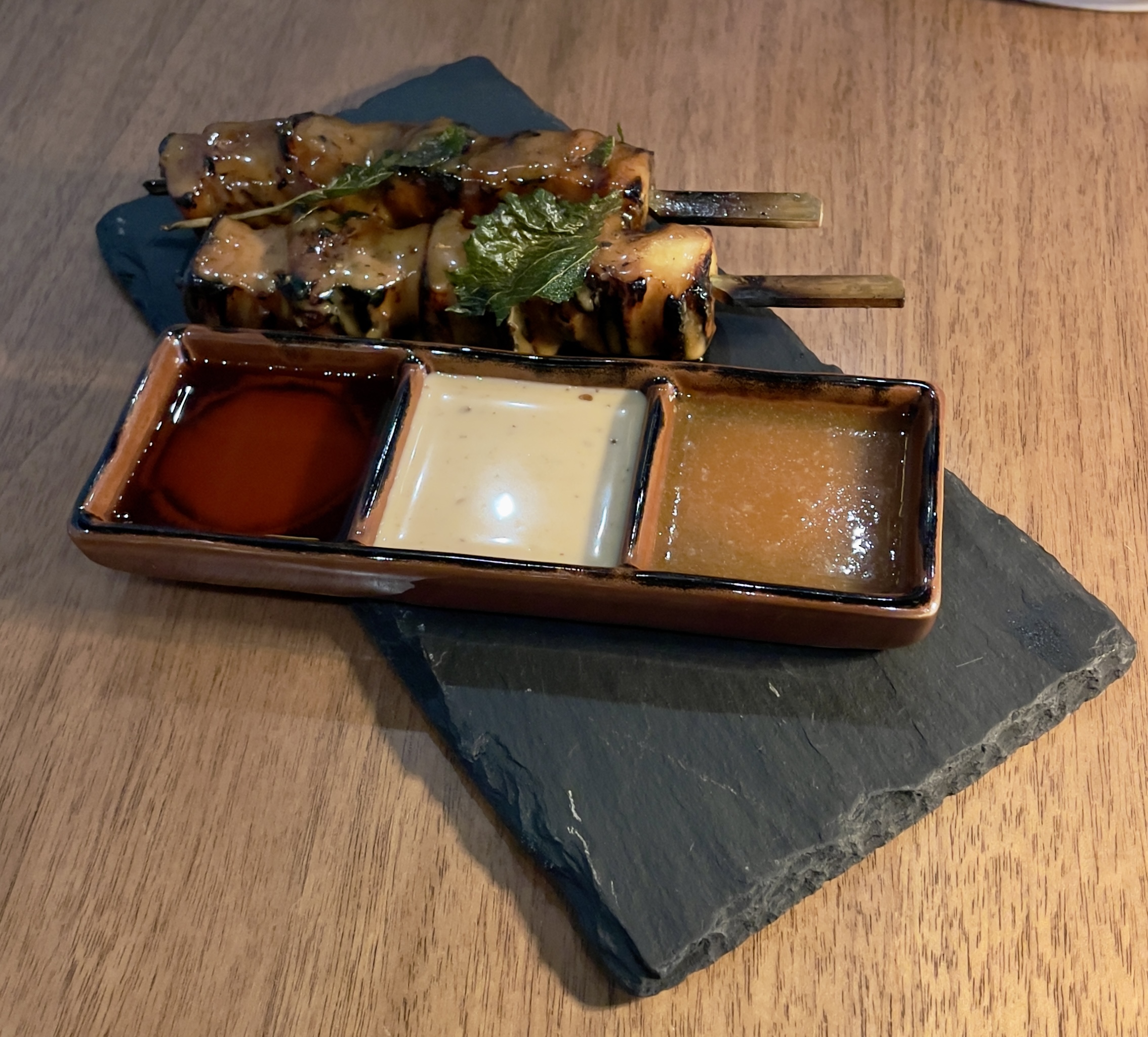
We ordered two side dishes to accompany our entrées. The truffle mashed potatoes were good, but the miso corn was fantastic! The kernels were freshly cut from the cob, grilled with miso butter, and served with queso fresco and microgreens.


For my main dish, I took a look at the “from the land” section of the the menu. I could choose from three American Wagyu steaks: ribeye, filet mignon, or New York. They all sounded great, though I was leaning toward the New York. However, one additional option caught my eye: “A5 Miyazaki Wagyu”.
Japanese Wagyu steaks are considerably more expensive than American or Australian Wagyu steaks, which are already more expensive than other steaks. However, they’re supposed to be much better than other steaks. I’d never tried one before, so I’ve always wondered if they really are superior to ordinary steaks or if it’s just hype. With piqued curiosity, I decided to finally find out.
You may have heard of Kobe steaks. I think Kobe beef has a more legendary reputation than Miyazaki steaks, though I hear reports that Miyazaki may actually be better. Both are varieties of Japanese Wagyu beef. The Miyazaki Wagyu seems to have won in head-to-head competition against the Kobe beef in recent meetings of the Wagyu Olympics.
All Miyazaki Wagyu beef comes from purebred cattle raised in the Miyazaki Prefecture of Japan. The cattle are genetically predisposed to develop high intramuscular fat content, which means they will have highly marbled meat. However, the way the cattle are raised also affects the quality of their meat. Miyazaki cattle are not raised in giant herds, as most American cattle are. Instead, ranchers specialize in this particular breed and raise only about four cattle at a time. This allows the ranchers to give plenty of attention to each animal, focusing on each cow’s needs. These animals receive enviable care, including a wholesome diet of corn, wheat, and barley.
The Market Price for my entrée was $100 for a five-ounce steak. That’s why I had never had one before. Was it worth it? I won’t attempt to answer that, as that answer is not only highly subjective, but also very dependent on one’s circumstances. I will say, however, that the quality of the steak was obvious from my first bite. It is demonstrably superior to “ordinary” steaks.
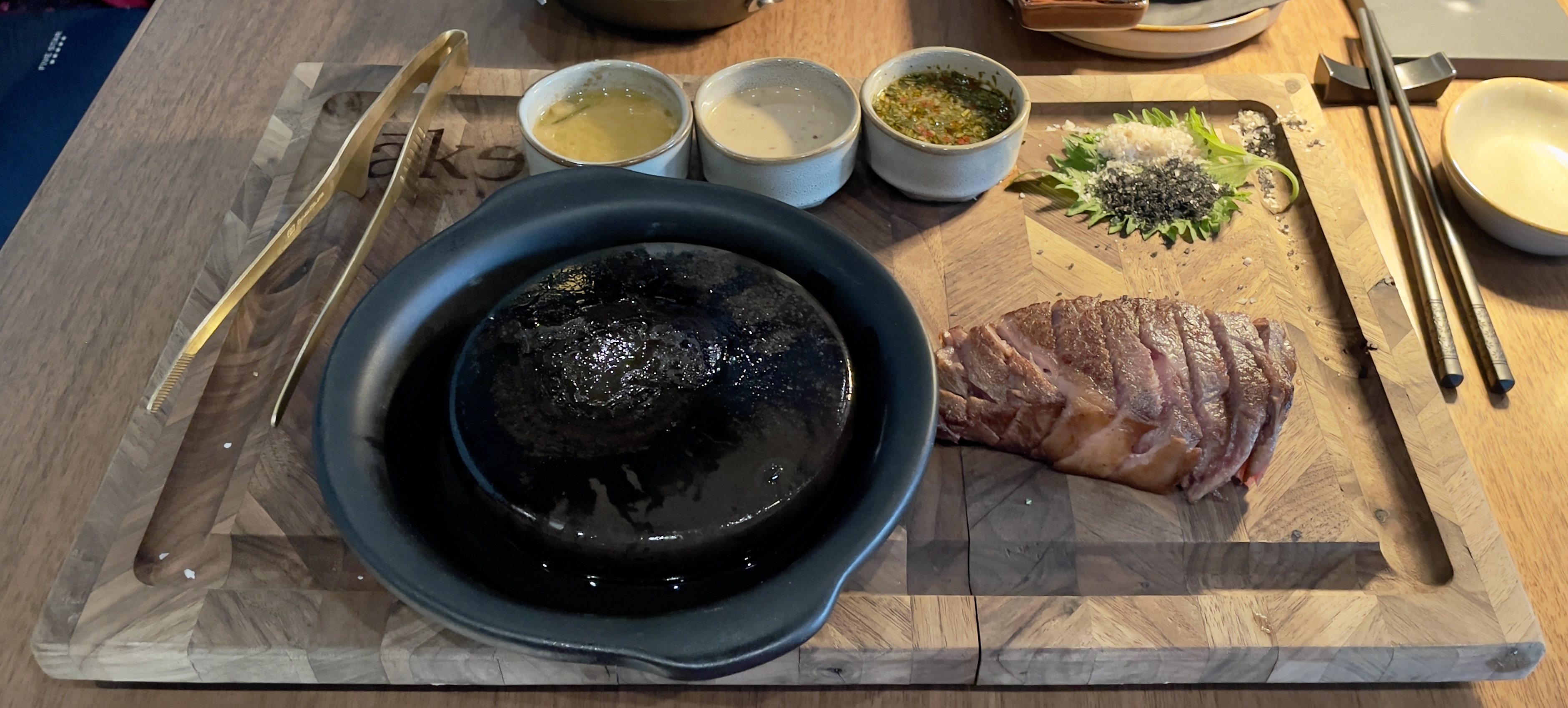
My steak came on a butcher block with a hot stone, three sauces, and two varieties of coarse salt placed artfully on a shiso leaf. The steak was cooked “Black and Blue,” which means it was briefly seared over very high heat but left mostly uncooked on the inside. It was already sliced, so I only needed to place the slices on the hot stone for a few seconds to cook them adequately. (The fat in a Miyazaki Wagyu steak starts to melt at 77°, so I didn’t want to overdo it).
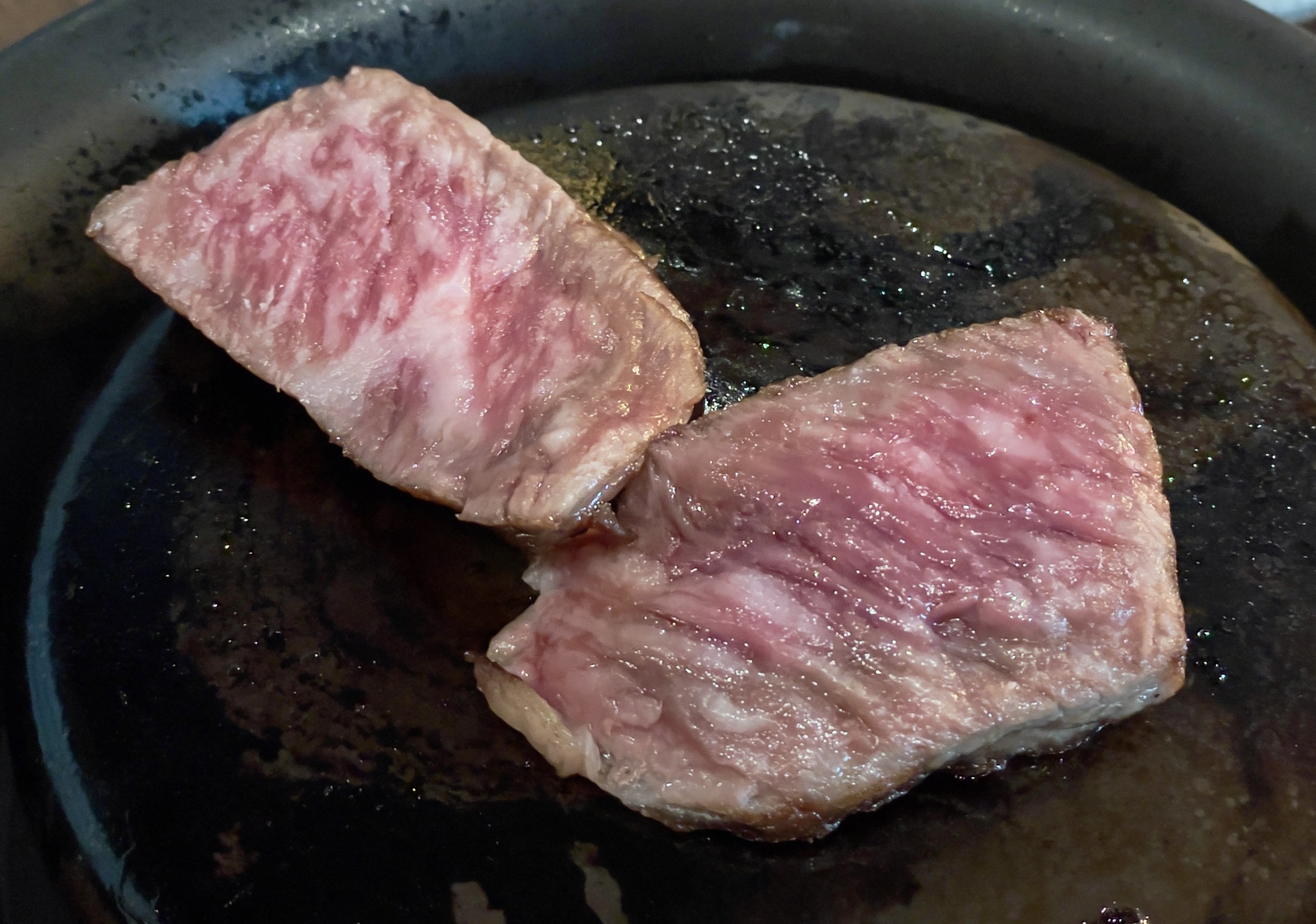
When I placed the first piece in my mouth, it just melted. Amazing. Like butter. Like candy, but full of deep, rich flavor. It was, by far, the best steak I’ve ever had.
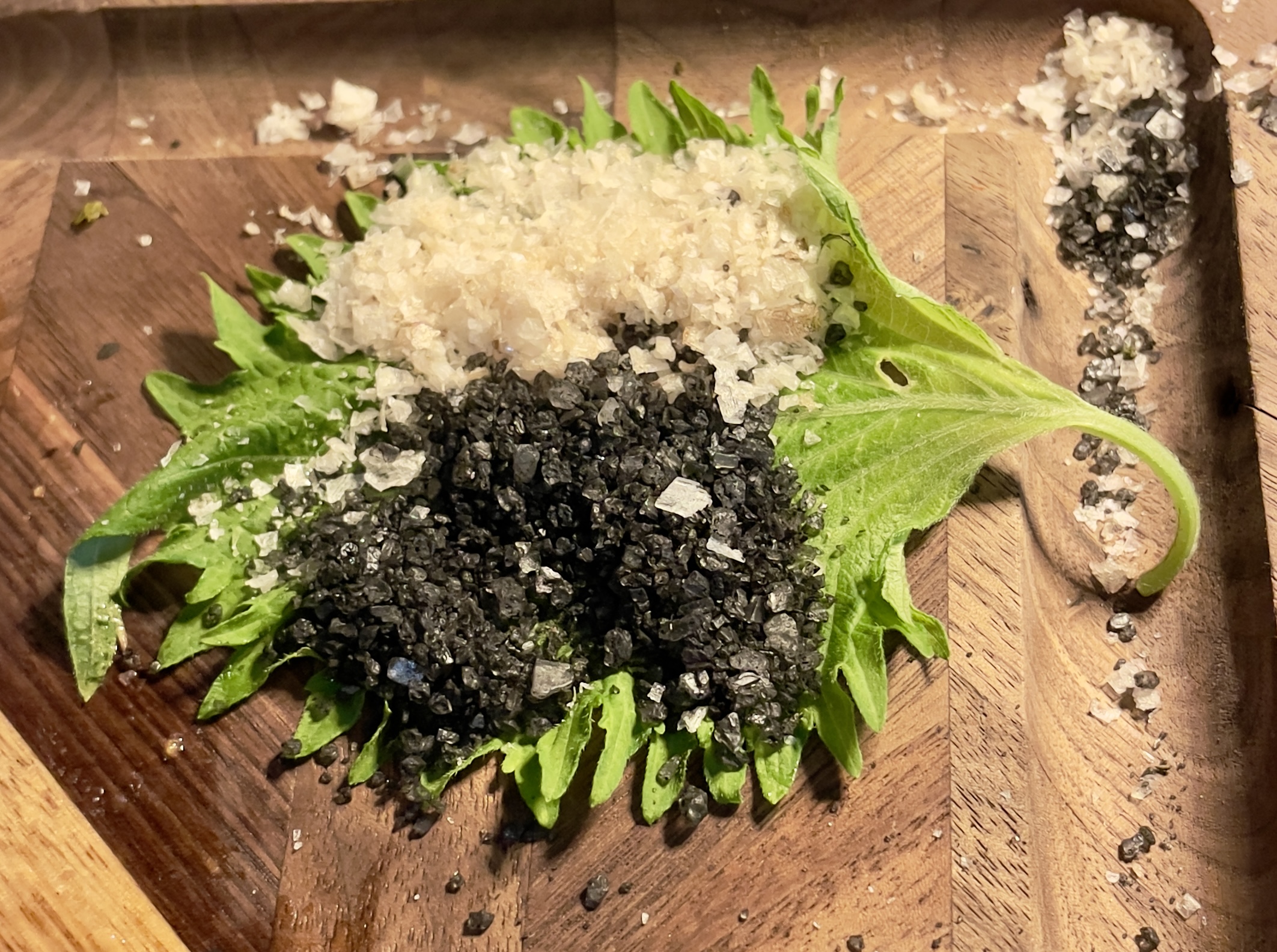
We finished with a bread pudding made from almond croissants. It had a great, firm texture. It came with a scoop of silky vanilla ice cream, sliced strawberries, blueberries, and pieces of caramelized apple.

She said:
It was Saturday night, and I was in the mood for fish, so I got excited when I looked at Aker’s online menu. Brian had told me that they specialized in seafood and steaks. Sold!
We drove to SLC and found a parking garage about a block away and walked to the restaurant. Upon our approach to the premises, I saw a building reminiscent of the ones that peppered the downtown districts of London, England: gray stones, concrete corbels, black metal trim wrapping the large windows and the entry doors—although it took a moment to figure out exactly where the entrance was located because it wasn’t clearly marked. But obviously, we figured it out. 🙂

Upon entering, we were greeted by a friendly hostess and led to a cozy, intimate-feeling, high-backed booth. I immediately felt comfortable and pampered. Once seated, I took stock of our surroundings.
Everything was sleek, chic, understated, and sophisticated. From the tall booth-backs in gray and cream geometric-patterned upholstery, the brown leather booth seats, the sage green leather modular chairs, the ecru-colored tile floors, and the black, shaded lamps on the nutmeg, woodgrain tables, everything exuded class. At one point, I looked up at the ceiling and was intrigued by the ropes suspended up there. They’d been arranged in a pattern that simulated a fishing net. I thought that was a lovely touch.
Finally, our waiter approached and asked if we had any questions. Yep, lots! And he patiently and helpfully walked us through the menu. (Incidentally, the menus were printed on nice paper and nestled inside of soft-as-butter leather covers). After understanding all of our options, we made a decision regarding the kind of meal we wanted.
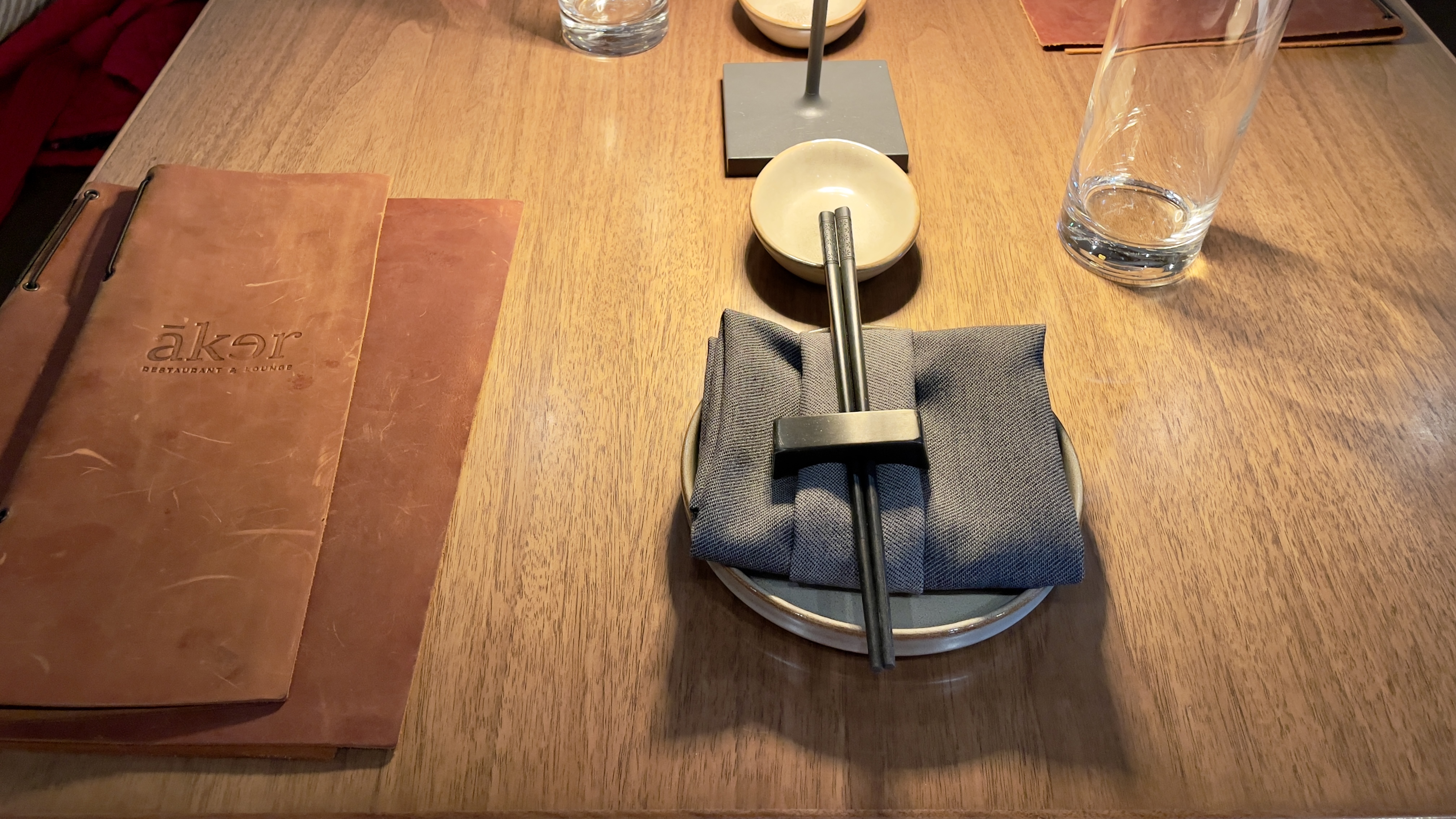
As Brian said, we started off with the “Sunomono Kimchee” salad. It looked beautiful, and I decided to give it a try upon assurances that the spiciness level was mild. Uh, nope! Wrong. Upon taking my first bite, I relished the crispness of the cucumbers and thought to myself, “Huh. This isn’t so bad!” And then the slow burn hit me in the back of the throat and had me grabbing for the pork belly and a bit of ginger plum sauce to cool things off. After that, I concentrated on eating my skewer of meat and gladly let Brian have all the cucumbers to himself.
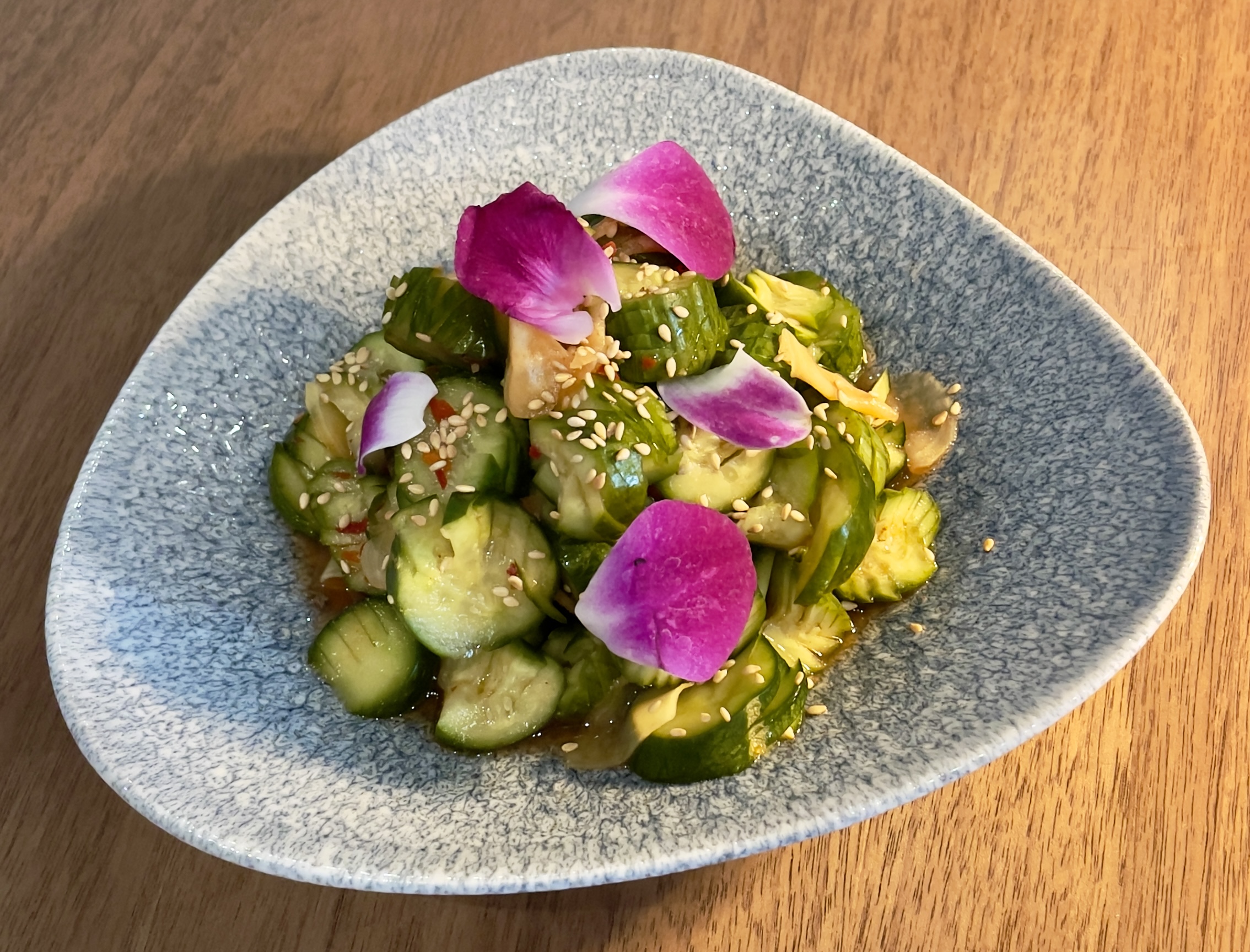
Now, once at the restaurant, I learned that Aker specializes in SUSHI where seafood is concerned. Huh. Sushi is not my thing at all, so I was a bit disappointed that the only cooked seafood offerings on the menu were Chilean seabass and some cod. It would have been better—for me, anyway—if there had been some grilled salmon, a lobster tail, or steamed or grilled scallops as part of Aker’s extensive offerings.
Anyway, I ordered the Chilean seabass for my entrée and was very pleased with my choice. The portion of the fish was generous, as I was presented with two thick, square pieces of perfectly moist and flaky bass sitting atop tender, baby red potato slices, grilled onions, and steamed spinach in a miso-truffle glaze and topped by a “haystack” of fried leeks. It was flavorful and very satisfying, a symphony of textures and seasonings.
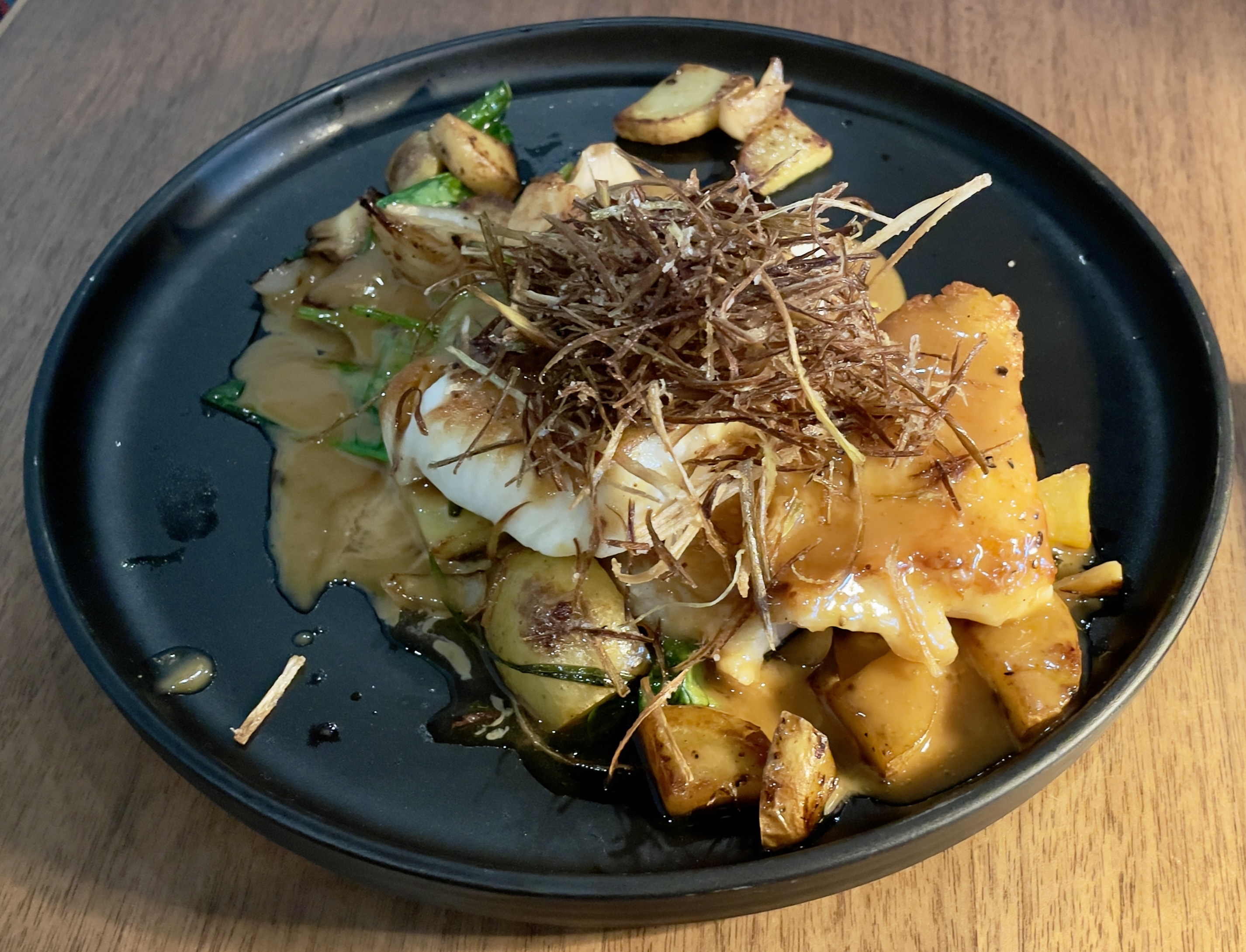
Although it felt as though I’d be unable to take one more bite of anything, we decided to order dessert. I’m so glad that we did because the almond bread pudding was positively wonderful. Not only did it look pretty on its white stoneware plate, it was a delectable treat. The pudding was made from almond croissants, which provided the subtle taste of almond extract and the crunch of the nuts. It was all topped off with a scoop of creamy vanilla bean ice cream and a garnish of fresh mint, cubed baked apples, fresh strawberries, large blueberries, and a smattering of confectioner’s sugar. It was positively delicious and pleased my palate enormously. No lie. It really was that delicious, in my opinion.
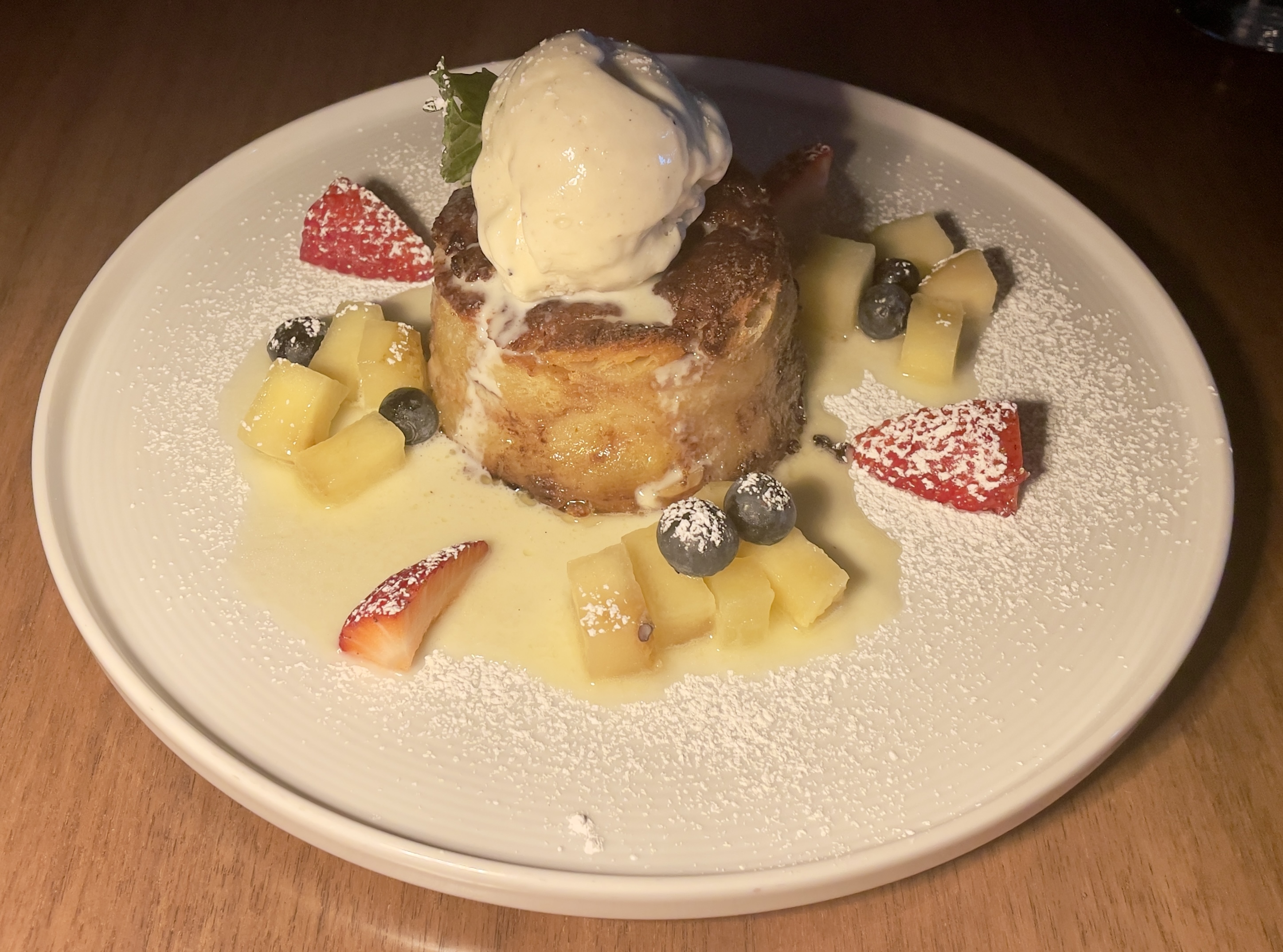
I left happy, having enjoyed great food and a wonderful culinary experience. A great Saturday night date with my hubby. ☺
P.S. — When Brian was presented with his Wagyu steak, he was kind enough to slice off a piece and hand it to me. After popping it into my mouth, Wow! I finally knew what the fuss is all about.
Conclusion:
For a memorable, sophisticated dining experience, head over to Aker Restaurant and Lounge. Aker is a 21+ establishment, so bring your ID and leave the children at home.